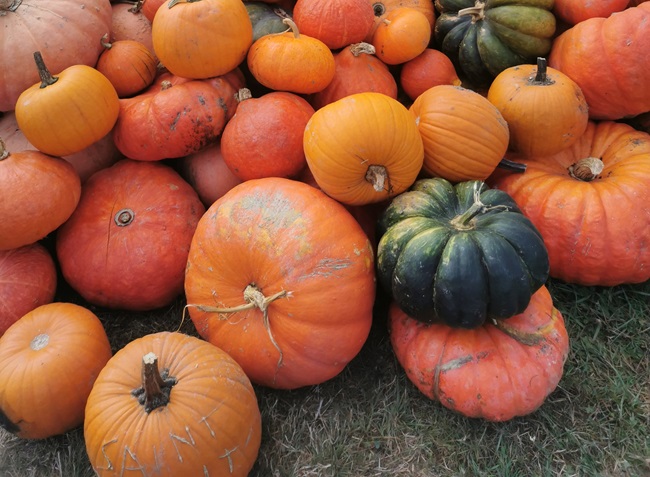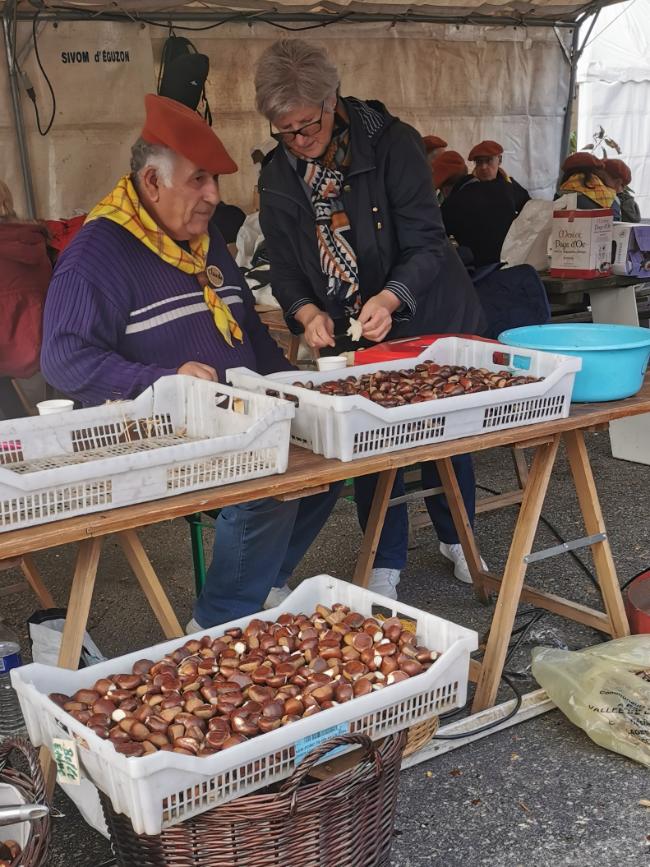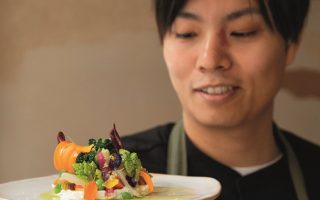A Tour of the Culinary Delights of the Creuse

In Creuse, in central France, traditional cuisine is still very much alive as recipes draw from the local, bountiful produce to make heart-warming dishes, whatever the season.
The French love food. Numerous festivals are devoted entirely to food and any misconception that French cuisine is not what it was is soon dispelled by a visit to a local market, a French supermarket or any of the bakeries and butchers still thriving in small towns throughout France today. Nowhere is this more apparent than in the Creuse, where French cuisine is very much alive and well and where ancient recipes still sit proudly on household and restaurant menus.
When a friend of mine gave me a beautiful cookery book of traditional recipes from the Creuse, she wrote in it ‘When our grandmothers cooked, little did they realise that they were providing an elixir for long life. Their food was natural and rustic, made from everything the earth can offer under the Creusois sky’.
The stark granite rocks of the Creuse contrast with green fields hedged in by sturdy hazelnut bushes, whose lacey-collared seeds provide the secret ingredient for a traditional nut cake. The pastures they guard are speckled with herds of equally sturdy white Charolais and brown Limousin cows, known throughout France for the quality of their meat and dairy products. It is an area of whispering woodlands, majestic chestnut trees whose polished fruit is the shining star at the heart of several regional food fairs.

Selling chestnuts on the Creuse markets © Anne Price
It is against this backdrop that an enduring culinary tradition has evolved. For food-focused writers and travellers, the Creuse is a gastronomic gem waiting to be discovered, where, as the waning summer days drop behind the horizon and the crisp, bracken-scented morning air heralds the coming of autumn, restaurants and auberges serve traditional dishes waiting to be savoured. The jewelled plates of summer salads give way to velvety soups and satisfying pies, melting fondues and desserts to die for. All the ingredients for these delights are available in the vibrant local markets, whose stalls offer a wide range of fruit, vegetables, meat, fish and local cheeses, and where chefs of local restaurants join others early in the morning to buy the fresh produce. As they navigate their way through the market, they join queues of people waiting their turn to be served. A word of advice – always greet the person who is serving you. ‘Good morning’ sets the tone for the transaction which is carried out with smiles and advice on what is and what is not so good on any particular day. Woe betides any impatient soul who tries to jump the queue. Chastised, the culprit slinks sheepishly away, or apologetically retreats to the end to wait patiently with everyone else and perhaps join in the chatter. This is something too important to hurry and they chatter and admire what is on offer: olives and dried fruits from one stall, spices from another, jars of honey, some creamy and opaque, others like liquid gold from another. Once decided upon, purchases are paid for and tucked into woven baskets with leather straps; and if you don’t have one of these, there is also a stall nearby with an array of baskets almost as mouthwatering to look at as the produce they are designed to carry.

Pâté de pomme de terre © Anne Price
Still untouched by the time constraints of living in the larger cities, in this secret place at the heart of France, time stands still at mealtimes, an homage to an important tradition. Here, there are no quick 45 minute ‘eating on the hoof’ lunch breaks. At midday, everything stops for two hours as the doors of the inns open and blackboards, all proudly displaying their midday menus, are placed outside for the hungry eyes of diners, drawn by the promise of the plat du jour or special dish-of-the-day. French Labour Law states that French employees should not have lunch ‘at their desks’. At mid-day, road-workers, farm-workers, electricity-workers, armed with their government-supplied chèque déjeuner (also known as ticket-restaurant) or lunch vouchers, down tools and head to the nearest restaurant, where they join other local people and tourists drawn by the tantalising menus on offer.
The French believe that food is one of life’s most important pleasures and lunch is usually leisurely, consisting of an entrée, (starter) a plat (main) and a dessert, often accompanied by a glass of wine. The French insist upon the importance of choosing wine carefully to accompany each dish. It is frowned upon to put several bottles of wine on the table for everyone to help themselves and in case I was unaware of this, I was very discreetly presented with a list of wines traditionally served with each course. Alongside locally bred beef, lamb, pork and duck, fresh produce grown in the rich soil of the region features prominently on the menu, providing the ingredients for the many mouthwatering gourmet dishes, creative soups, pies and desserts unique to this part of France.
The summer courgettes and tomatoes, make way for butternuts and pumpkins associated with la Toussaint or All Saints, a festival to honour the dead, which falls the day after Halloween. As the festival coincides with the potato harvest it is not surprising to find potato dishes on restaurant menus. Pâté de Pomme de Terre – Potato Pie with a difference – is everyone’s favourite. A traditional Creusois recipe, it is made with layers of sliced potatoes and onions, sometimes containing pieces of local ham and encased in mouthwatering shortcrust or flaky pastry. Towards the end of cooking time, crème fraîche is poured into it through an incision made in the top. Browse the menus to find other dishes such as fondue Creusoise made from a locally produced camembert and served with country ham and baked potato or French fries, followed by traditional desserts such as gâteau Creusois a delicious hazelnut cake, for which everyone has their own unique recipe; and Clafoutis gleaming with seasonal cherries or pears. If you cannot choose go for the café gourmand which consists of a cup of coffee served with a small taste of each of the special desserts of the day. Food brings everyone together and there is no more beautiful tapestry than that of the sunny garden or aroma-rich, welcoming interior of a restaurant where people from all walks of life stop to sit back and enjoy a wonderful meal.

Autumn harvest © Anne Price
Autumn arrives in a flurry of fairs devoted entirely to the produce of the land. There is an annual Apple Fair where anyone who has an abundant crop of apples can bring their fruit to be turned into apple juice or cider. The Creuse village of Saint-Laurent comes alive when the Pumpkin Fair attracts hoards of visitors looking for pumpkins to celebrate Halloween and the festival of Toussaints. A field becomes a carpark for the day and on the walk from the car to the village people stream past, clutching their purchases, smiling happily. Some carry boxes, others push wheelbarrows piled high with yellow and red pumpkins and butternuts. Children proudly carry their orange treasures home to be carved and decorated for Halloween. Wherever you look, a glorious riot of pumpkins meets the eye. Centre stage stands a fantastical specimen, a carriage fit for a thrifty princess, who, on the stroke of midnight will already be thinking of the soups and pies it is going to provide for her family.
By the end of October, the trees lining the rural roads and lanes have scattered their polished fruit, and there is an abundance of chestnuts just waiting to be picked from where they have fallen. They can be roasted over hot coals, blanched, peeled, and frozen, or made into flour, jams, liqueurs, and syrups. ‘Fara’ is a recipe which has been handed down in families for generations and one which Elisabeth Pradeau, an enthusiastic chef and gîte-owner says is very popular with her guests. “It can be eaten warm for breakfast with a sweet latte or cold at any time of day,” she informs me. “First make a short-crust pastry. Put in the fridge to rest, while preparing the chestnuts. Remove the first skin from the chestnuts with a knife, scald them to remove the second skin and dry them. Roll out the dough, fill it with the chestnuts with no space between them. Fold the dough around the chestnuts, sealing the edges to make a 10 cm diameter sausage. Brush the dough with beaten egg yolk and put in a very hot oven at 200°C for 10 minutes. Reduce to 180 °C for 20 minutes. Prick with a knife to see if it’s cooked. Leave to rest for five minutes, then serve and enjoy.”

Carriage for a princess © Anne Price
My long-abiding memory of a visit to Paris in a previous life when I was barely a teenager, is one of the aroma of roasting chestnuts on street corners and the joy of buying a cone of the gorgeous, charred nuts. Which is why I love to visit the three-day Chestnut Fair held each November in Eguzon, a picturesque village claimed by both the Creuse and the Indre. Here, for a few hours I can revisit that memory as, like an excited child I head for the braziers to purchase my cone. The festive mood is contagious as people of all ages flock here to mark the inauguration of autumn. The only other time I had ever tasted chestnuts was as an ingredient in traditional stuffing for turkey or duck so I was delighted to find at the fair, four guest chefs from the National Academy of Cuisine. Fabrice Corbonnois, Kim Lam Tham, the former head chef of the Vietnamese embassy in Paris, Emma Lam Tham, and Saima Riaz were there to demonstrate the chestnut’s culinary versatility and share their Gourmet chestnut-based recipes. Between them they created delicious dishes such as lentils with chestnuts accompanied with a shallot and garlic vinaigrette, a chestnut flour brioche blended and sprinkled over the lentils; an “autumn roll” topped with beet leaves and stems, caramelized chestnuts with lime, carrot and zucchini tagliatelle and flat-leaf parsley, served with a sauce made from chestnut liqueur, soy sauce, fried shallots, peanut paste, peanut and chestnut puree, a true gourmet chestnut experience way up there with the roasted variety.
The French love creating amazing dishes from the produce available in every season. A trip into its culinary history, will reveal the tried and tested gastronomic delights of the Creuse. Explore how the simple, versatile ingredients of these dishes fit so well with the adventurous creations of international chefs. As autumn closes summer’s door, it opens another to the approaching Christmas celebrations and the promise of more mouthwatering recipes to round off the year.
Lead photo credit : End of year bounty © Anne Price
Share to: Facebook Twitter LinkedIn Email
More in Creuse, French food, french gastronomy, Limousin
By Anne Price
Leave a reply
Your email address will not be published. Required fields are marked *




REPLY